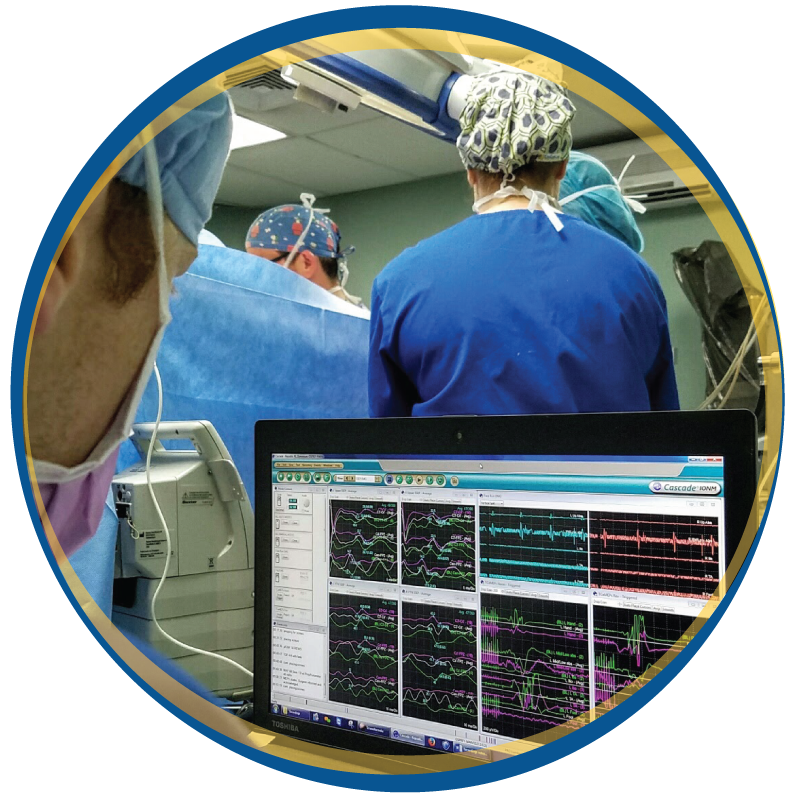Intraoperative Neuromonitoring
Surgery can be unpredictable and potentially dangerous especially when it involves areas near the brain, spinal cord, or nerves. Intraoperative monitoring (IOM) allows for the nervous system to be monitored in real-time and is proven to make surgeries safer.
At NW Monitoring we are focused on the pursuit of excellence in clinical outcomes and customer service. Our IOM technologist is part of your surgical team and helps to assess the health of your nervous system throughout the procedure. They identify developing neurological issues and communicate potential complications to your surgeon. This allows for corrections to be implemented promptly to avoid or mitigate long-term neurological deficit.
If you have questions about IOM and how it can help protect your nervous system’s function, please see our FAQ’s section.
You’ve Got Questions? We’ve Got Answers
For more information you can view our FAQs below or call us at (360) 740 3538
-
Intraoperative Monitoring (IOM) provides your surgeon with real-time feedback on the function and health of your nervous system throughout your surgical procedure. The use of IOM mitigates some of the risks inherent to surgeries involving the spinal cord and nerves by alerting your surgical team to potential injuries before they cause post-surgical deficits.
-
Our IOM technologist will be an integral part of your surgical team and will be in the room with you throughout your surgery. After anesthesia has taken effect, our technologist will attach a series of electrodes at different points on your body depending on the type of surgery being performed and the areas at risk. Once the electrodes are in place they are connected to specialized monitoring equipment which is used to run tests on your neurological function.
Using sophisticated and secure telemedicine services, your neural responses will be monitored onsite by our technologist and remotely by one of NW Monitoring’s supervising neurologists . If changes occur during the procedure our technologist will alert your surgeon who will take immediate action.
-
The Electroencephalogram (EEG)
This test is a recording of the brain’s on-going electrical activity. EEG assists in the diagnosis of various brain disorders and assures the surgeon that the brain is receiving enough oxygen.
The Somatosensory Evoked Potential (SSEP)
This test measures the transmission of sensation above and below the area of surgery. Electrodes are stimulated with an electrical current at the hands and feet and the response is recorded as the signal travels to the brain. This process checks the function of the sensory portion of the nerves and spinal cord.
The Motor Evoked Potential (MEP)
The MEP test involves the electrical stimulation of the motor cortex using electrodes on the scalp. This stimulation illicits a motor response causing movement of the extremities. This process checks the function of the motor portion of the nerves and spinal cord.
Electromyography (EMG)
This test evaluates electrical potentials from spinal nerve roots and peripheral nerves. Electrodes are placed into the muscles that are controlled by the nerves at risk and monitored for activity which helps the surgeon ensure the nerves are not damaged during certain surgical procedures.
Pedicle Screw Testing
These tests assist surgeons during the placement of hardware in spine surgeries. Surgeons place a probe over the pedicle screw which delivers a small electrical current and verifies that no breach or crack in the bone occurred during screw placement.
Brainstem Auditory Evoked Responses (BAER, BAEP, BEP)
Brainstem evoked potentials are obtained by stimulating the auditory system using click stimuli. These clicks illicit neural action potentials and are used to evaluate disturbances of the auditory nerve along with retractor disturbances of the brainstem.
-
Your safety is our number one priority which is why all of our IOM technologists are board certified or eligible to obtain The Certificate in Neurophysiologic Intraoperative Monitoring (CNIM®). The CNIM® is awarded by the American Board of Electroencephalographic and Evoked Potential Technologists (ABRET®) and is recognized as the standard for IOM technologists. Our protocols and procedures are also written according to the technical and clinical standards set by ABRET®. With NW Monitoring you can rest assured that you are being attended by highly trained and experienced technologists.
For further information please go to the American Board of Electroencephalographic and Evoked Potential Technologists Website:
-
Many complications involving the nervous system can be avoided with careful monitoring during surgery. Your surgeon recognizes the advantage of IOM as another tool in addition to his or her own surgical skill along with its proven benefit to improve the outcomes of surgery.
